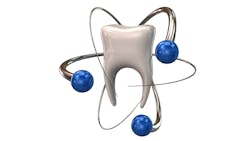Acidic adversary: Unveiling the magic of nanohydroxyapatite
If teeth could talk, what would they tell us? I imagine they would ask us to protect them against the acidic conditions we often expose them to. Our teeth would insist we introduce materials that possess cariostatic properties, defend against demineralization, and have the ability to neutralize acids. Additionally, our teeth would likely prefer materials that offer a more pleasant taste. Luckily, there are material solutions that fulfill all these wishes!
Remin Pro to the rescue
Remin Pro by Voco is a water-based dental cream offering the triple protection of sodium fluoride, nanohydroxyapatite, and xylitol.1 It not only safeguards against demineralization and erosion, but it also assists in decreasing dentinal hypersensitivity. It can be used chairside and at home.1 Remin Pro has a high fluoride content of 1,450 ppm and is casein free, making it a great option for those with milk protein allergies.1
Remin Pro helps to naturally remineralize and protect tooth enamel. Both fluoride and xylitol act as cariostatic agents. Xylitol has an excellent buffering capacity and benefits the oral microbiome. Remin Pro is available in melon, mint, and strawberry flavors. My personal favorite is the melon flavor.
Fun facts about nanohydroxyapatite
Enamel is mostly comprised of naturally occurring calcium and phosphate minerals, also known as hydroxyapatite. The synthetic version of hydroxyapatite is called nanohydroxyapatite. It is nontoxic and closely resembles the inorganic substances in teeth. NASA was the first to develop nanohydroxyapatite more than 50 years ago to help restore minerals lost in the teeth and bones of astronauts during their time in space.2 Nanohydroxyapatite has been used in toothpaste in Japan since 1978 and was approved for caries prevention in 1993.2
Nanohydroxyapatite works by filling in and repairing the porous areas of the tooth. This creates a smooth layer of protection and promotes remineralization. Furthermore, it seals the dentinal tubules and reduces hypersensitivity. Other uses of hydroxyapatite include as a coating for dental implants, in orthodontics, for bleaching, and protection against dentinal hypersensitivity.3 Nanohydroxyapatite hinders the colonization of Streptococcus mutans.3
Clinical relevance of nanohydroxyapatite
Consumption of carbonated and acidic beverages has become increasingly popular among all ages.4 Frequent use of these drinks intensify the risk of dental erosion, demineralization, hypersensitivity, and dental caries. Coffee, alcoholic beverages, sports drinks, and fruit-infused water are also highly acidic. Unfortunately, the public is not always aware of the hidden dangers associated with these beverages.
Assessing the risks of nanohydroxyapatite
I encourage you to ask your patients about their use of acidic beverages. If you observe dental erosion, a white spot lesion, or if a patient reports hypersensitivity, consider asking them to keep a log of their drinks and snacks to help assess the root cause. Patients in orthodontic treatment are at high risk for white spot lesions. Your patients who struggle to achieve adequate oral hygiene and those with reduced salivary flow are among those with the highest risk for erosion and demineralization. Stress and anxiety contribute to a reduction in saliva and, consequently, dry mouth due to the sympathetic nervous system.5 Individuals with gastroesophageal reflux, substance use, bulimia, and those who vape are all at risk for dental erosion.6 Also, pay close attention to patients who exercise and participate in water sports as they experience a higher frequency of dental erosion.7,8
Chairside or home use
One of the first clinical signs of demineralization is the appearance of a white spot lesion due to loss of minerals in the tooth. In vitro studies have shown that Remin Pro increases the microhardness of enamel in white spot lesions, while clinical trials demonstrate an improvement in the appearance of white spot lesions.9-11
Remin Pro can be used chairside after a hygiene appointment or following teeth-whitening procedures to help with hypersensitivity. It is also recommended for use during and after orthodontic treatment.11 CDT code 9910 may be used when applying Remin Pro as a desensitizing medicament in the office.
When used at home, patients should apply a pea-sized amount of cream to their teeth and distribute it through the mouth with their tongue. For optimal results, it is best not to rinse and to wait for 30 minutes before eating or drinking.
Final thoughts
Supporting patients in maintaining good oral health throughout their lifespan can feel like a balancing act. While we may not be in control of the choices they make, we have an ethical obligation to provide them with the information they need to make an informed decision.
Editor's note: This article appeared in the June 2024 print edition of RDH magazine. Dental hygienists in North America are eligible for a complimentary print subscription. Sign up here.
References
- Remin Pro Protective dental care with fluoride and hydroxy apatite. Voco Gmbh. https://www.voco.dental/en/portaldata/1/resources/products/folders/gb/remin-pro_fol_gb.pdf
- Chen L, Al-Bayatee S, Khurshid Z, Shavandi A, Brunton P, Ratnayake J. Hydroxyapatite in oral care products – a review. Materials (Basel). 2021;14(17):4865. doi:10.3390/ma14174865
- Pushpalatha C, Gayathri VS, Sowmya SV, et al. Nanohydroxyapatite in dentistry: a comprehensive review. Saudi Dent J. 2023;35(6):741-752. doi:10.1016/j.sdentj.2023.05.018
- Inchingolo AM, Malcangi G, Ferrante L, et al. Damage from carbonated soft drinks on enamel: a systematic review. Nutrients. 2023;15(7):1785. doi:10.3390/nu15071785
- Gholami N, Hosseini Sabzvari B, Razzaghi A, Salah S. Effect of stress, anxiety and depression on unstimulated salivary flow rate and xerostomia. J Dent Res Dent Clin Dent Prospects. 2017;11(4):247-252. doi:10.15171/joddd.2017.043
- Fairchild R, Setarehnejad A. Erosive potential of commonly available vapes: a cause for concern? Br Dent J. 2021;231(8):487-491. doi:10.1038/s41415-021-3563-1
- Schulze A, Busse M. Sports diet and oral health in athletes: a comprehensive review. Medicina (Kaunas). 2024;60(2):319. doi:10.3390/medicina60020319
- Nijakowski K, Walerczyk-Sas A, Surdacka A. Regular physical activity as a potential risk factor for erosive lesions in adolescents. Int J Environ Res Public Health. 2020;17(9):3002. doi:10.3390/ijerph17093002
- Nourolahian H, Parisay I, Mir F. The effect of Remin Pro on the microhardness of initial enamel lesions in primary teeth: an in vitro study. Dent Res J (Isfahan). 2021;18:16.
- Aboulnaga MA, Akah MM, Hassanein OES. Evaluation of remineralization potential of Remin Pro Forte vs Remin Pro on white spot lesions: a randomized clinical trial. J Contemp Dent Pract. 2022;23(5):520-526.
- Heravi F, Ahrari F, Tanbakuchi B. Effectiveness of MI Paste Plus and Remin Pro on remineralization and color improvement of postorthodontic white spot lesions. Dent Res J (Isfahan). 2018;15(2):95-103.
About the Author

Jeannette Diaz, MPH, MS, RDHAP, RDH
Jeannette Diaz, MPH, MS, RDHAP, RDH, FADHA, is a keynote speaker, independent dental hygienist, and educator. She currently works for the California Department of Developmental Services and teaches graduate and undergraduate studies. Her area of expertise is working with individuals with developmental disabilities, and her interests include qualitative research, grief literacy, and public health. Email her at [email protected] or find her on Instagram @californiaRDHAP.

